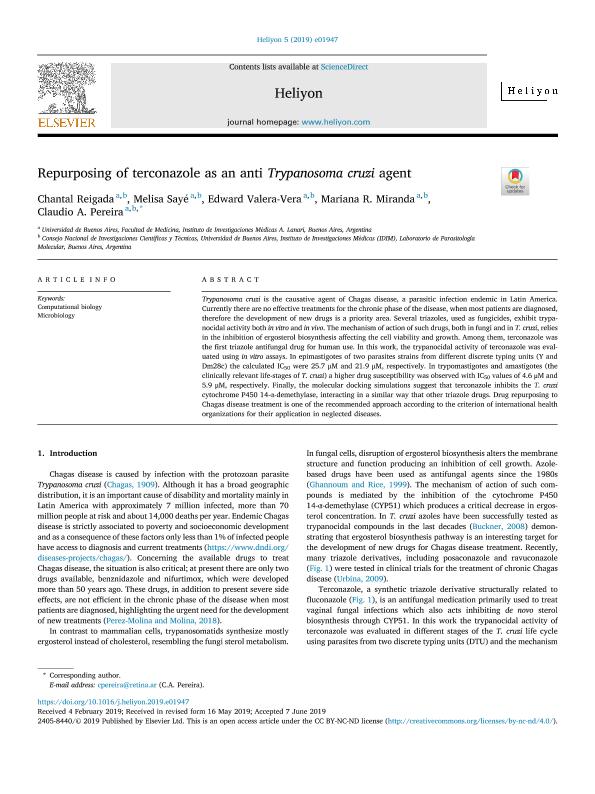Artículo
Repurposing of terconazole as an anti Trypanosoma cruzi agent
Reigada, Chantal ; Martínez Sayé, Melisa Soledad
; Martínez Sayé, Melisa Soledad ; Valera Vera, Edward Augusto
; Valera Vera, Edward Augusto ; Miranda, Mariana Reneé
; Miranda, Mariana Reneé ; Pereira, Claudio Alejandro
; Pereira, Claudio Alejandro
 ; Martínez Sayé, Melisa Soledad
; Martínez Sayé, Melisa Soledad ; Valera Vera, Edward Augusto
; Valera Vera, Edward Augusto ; Miranda, Mariana Reneé
; Miranda, Mariana Reneé ; Pereira, Claudio Alejandro
; Pereira, Claudio Alejandro
Fecha de publicación:
01/06/2019
Editorial:
Elsevier
Revista:
Heliyon
ISSN:
2405-8440
Idioma:
Inglés
Tipo de recurso:
Artículo publicado
Clasificación temática:
Resumen
Trypanosoma cruzi is the causative agent of Chagas disease, a parasitic infection endemic in Latin America. Currently there are no effective treatments for the chronic phase of the disease, when most patients are diagnosed, therefore the development of new drugs is a priority area. Several triazoles, used as fungicides, exhibit trypanocidal activity both in vitro and in vivo. The mechanism of action of such drugs, both in fungi and in T. cruzi, relies in the inhibition of ergosterol biosynthesis affecting the cell viability and growth. Among them, terconazole was the first triazole antifungal drug for human use. In this work, the trypanocidal activity of terconazole was evaluated using in vitro assays. In epimastigotes of two parasites strains from different discrete typing units (Y and Dm28c) the calculated IC50 were 25.7 μM and 21.9 μM, respectively. In trypomastigotes and amastigotes (the clinically relevant life-stages of T. cruzi) a higher drug susceptibility was observed with IC50 values of 4.6 μM and 5.9 μM, respectively. Finally, the molecular docking simulations suggest that terconazole inhibits the T. cruzi cytochrome P450 14-α-demethylase, interacting in a similar way that other triazole drugs. Drug repurposing to Chagas disease treatment is one of the recommended approach according to the criterion of international health organizations for their application in neglected diseases.
Palabras clave:
COMPUTATIONAL BIOLOGY
,
MICROBIOLOGY
Archivos asociados
Licencia
Identificadores
Colecciones
Articulos(IDIM)
Articulos de INST.DE INVEST.MEDICAS
Articulos de INST.DE INVEST.MEDICAS
Citación
Reigada, Chantal; Martínez Sayé, Melisa Soledad; Valera Vera, Edward Augusto; Miranda, Mariana Reneé; Pereira, Claudio Alejandro; Repurposing of terconazole as an anti Trypanosoma cruzi agent; Elsevier; Heliyon; 5; 6; 1-6-2019
Compartir
Altmétricas



